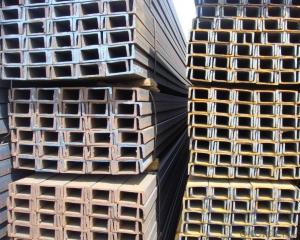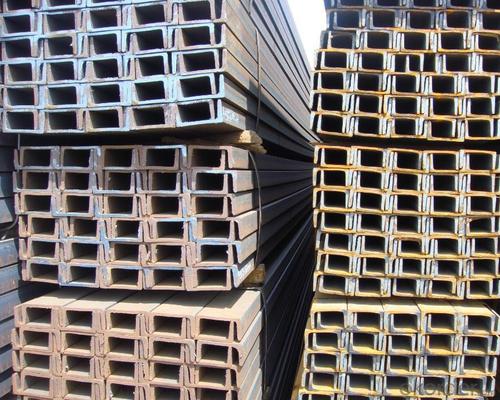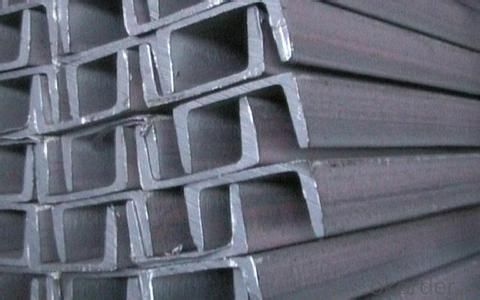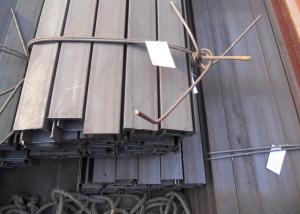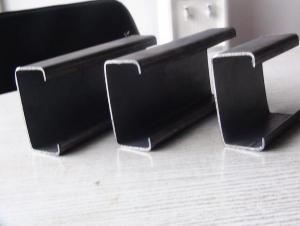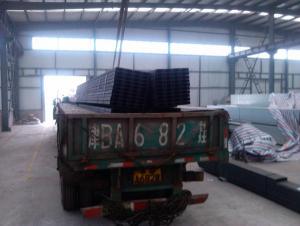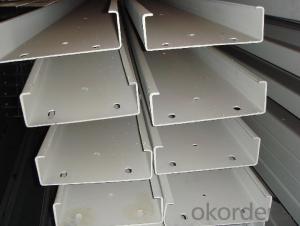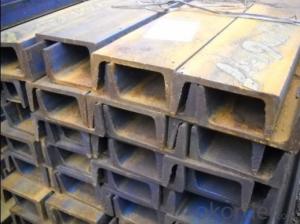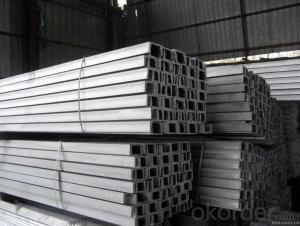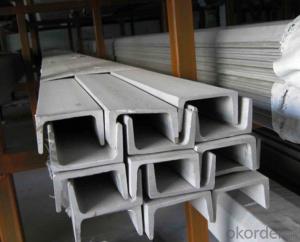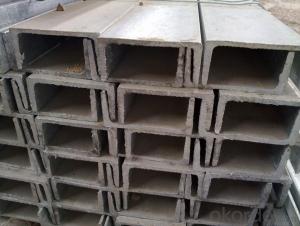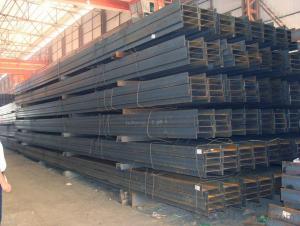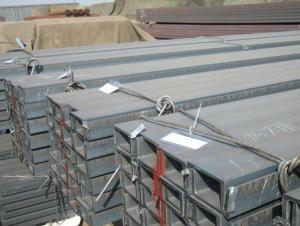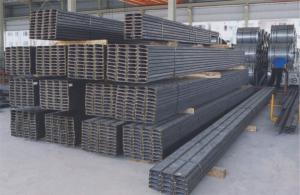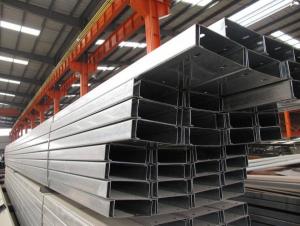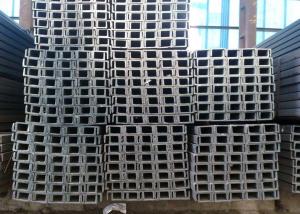High Quality Hot Rolled UPN,UPE for Structure Construction
- Loading Port:
- Tianjin
- Payment Terms:
- TT or LC
- Min Order Qty:
- 25 m.t.
- Supply Capability:
- 200000 m.t./month
OKorder Service Pledge
OKorder Financial Service
You Might Also Like
Product Description:
OKorder is offering High Quality Hot Rolled UPN,UPE for Structure Construction for Strcutures at great prices with worldwide shipping. Our supplier is a world-class manufacturer of steel, with our products utilized the world over. OKorder annually supplies products to European, North American and Asian markets. We provide quotations within 24 hours of receiving an inquiry and guarantee competitive prices.
Product Applications:
High Quality Hot Rolled UPN,UPE for Structure Construction are ideal for structural applications and general fabricating. The steel u channel can be applied to construction of warehouses, workshops, sport stadiums and car parks etc. In details, the steel u channel belongs to carbon structural steel which is applied to in the field of construction and machinery. The steel u channel is usually used for arch-itechtural structure, and they could be welded in order to support or hang a vari-ety of facilities. They are also usually used in combination with I beam. Generally,the steel u channel must possess perfect welding property, riveting property and mechanical property and so on.
Product Advantages:
High Quality Hot Rolled UPN,UPE for Structure Construction are durable, strong, and resists corrosion.
Main Product Features:
· Premium quality
· Prompt delivery & seaworthy packing (7-10 days after receiving deposit)
· Corrosion resistance
· Can be recycled and reused
· Mill test certification
· Professional Service
· Competitive pricing
Product Specifications:
High Quality Hot Rolled UPN,UPE for Structure Construction Details:
Minimum Order Quantity: 25 Tons Unit: m.t. Loading Port: Xingang Port
Supply Ability: 1000 Tons Per Day Payment Terms: TT or L/C
Product Description:
Specifications of High Quality Hot Rolled UPN,UPE for Structure Construction:
Standard Applied: GB Standard, EN Standard(UPN), JIS Standard
Sizes: 50mm to 300mm
Material Grade: Q235B, Q345B, S235JR, SS400, ASTM A36
As shown in the figure:

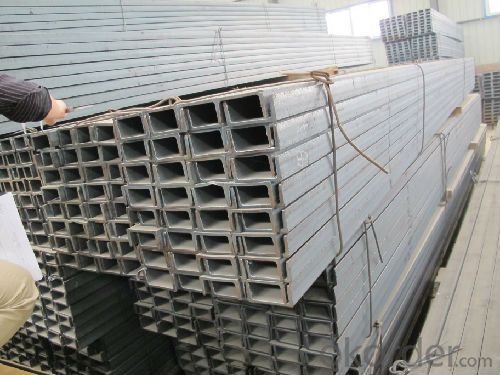
FAQ
Q1: How do we guarantee the quality of our products?
A1: We have established an advanced quality management system which conducts strict quality tests at every step, from raw materials to the final product. At the same time, we provide extensive follow-up service assurances as required.
Q2: Can fit in the containers of 20inches the steel beams of 6M?
A2: No proble, we can put them into the containers in the form sideling.
Q3: The products are invoicing on theoritical weight or on actual weight?
A3: We can do it in both manners, according to the customers' request.
- Q: What are the different manufacturing processes for steel channels?
- There are several different manufacturing processes for steel channels, including hot rolling, cold rolling, and extrusion. Hot rolling involves heating the steel billet and passing it through a series of rollers to create the desired shape. Cold rolling, on the other hand, involves passing the steel through rollers at room temperature to achieve the desired shape. Extrusion is another process where the steel is forced through a die to create the channel shape. Each process has its own advantages and is used depending on the specific requirements of the steel channel.
- Q: Can steel channels be used for conveyors?
- Certainly, conveyors can utilize steel channels. In conveyor systems, steel channels are usually employed to furnish structural reinforcement and steadfastness. They frequently serve as the backbone for the conveyor system, furnishing a robust foundation for other constituents like rollers, belts, and motors. Steel channels present exceptional strength, durability, and resilience to deterioration, rendering them appropriate for managing substantial loads and extended periods of operation. Furthermore, steel channels can be conveniently personalized and manufactured to accommodate precise conveyor needs, offering versatility in both design and installation.
- Q: What are the different surface finishes available for painted steel channels?
- Some of the different surface finishes available for painted steel channels include smooth, matte, satin, and high gloss finishes. These finishes can be achieved through various techniques such as sandblasting, powder coating, or using different types of paints or coatings. The choice of surface finish depends on the desired aesthetic appearance and the level of durability or resistance required for the specific application.
- Q: How do steel channels contribute to indoor air quality?
- Steel channels do not directly contribute to indoor air quality. Steel channels are structural components used in construction, typically for framing and supporting various building elements. They are made from steel, which is known for its strength and durability. However, when it comes to indoor air quality, steel channels indirectly contribute by supporting the overall structural integrity of the building. By providing a strong and stable framework, steel channels help maintain the building's structural integrity, preventing the ingress of outdoor pollutants, moisture, and allergens. This can help in creating a healthier indoor environment by reducing the chances of mold growth, water damage, and the infiltration of pollutants from the surrounding environment. Furthermore, steel channels are often used in HVAC (heating, ventilation, and air conditioning) systems. These systems play a crucial role in maintaining indoor air quality by providing proper ventilation, controlling temperature and humidity levels, and filtering out airborne particles. Steel channels are used in ductwork and air distribution systems, ensuring the smooth and efficient flow of conditioned air throughout the building. In summary, while steel channels themselves do not directly contribute to indoor air quality, their use in construction and ventilation systems indirectly helps in maintaining a healthier indoor environment by ensuring structural stability and supporting proper ventilation.
- Q: What are the different methods of finishing steel channels?
- There are several methods of finishing steel channels, each with its own unique characteristics and benefits. Some of the most common methods include: 1. Hot-dip galvanizing: This process involves immersing the steel channels in a bath of molten zinc. The zinc coating provides excellent corrosion resistance, making it ideal for outdoor applications. Hot-dip galvanizing also creates a durable and long-lasting finish. 2. Powder coating: Powder coating involves applying a dry powder to the steel channels and then curing it under heat. This method provides a thick and even coating that is highly resistant to chipping, scratching, and fading. Powder coating is available in a wide range of colors and finishes, allowing for customization. 3. Paint coating: Steel channels can also be finished with various types of paint coatings. These coatings provide both aesthetic appeal and protection against corrosion. Paint coatings can be applied using spray guns, brushes, or rollers, and they offer flexibility in terms of color and texture. 4. Electroplating: Electroplating is a process in which a thin layer of metal, such as chrome or nickel, is bonded to the steel channels through an electrochemical reaction. This method enhances the appearance of the steel channels, providing a decorative and lustrous finish. Electroplating can also improve the corrosion resistance of the steel. 5. Anodizing: Anodizing is primarily used for finishing aluminum channels but can also be used on steel channels. It involves creating an oxide layer on the surface of the metal through an electrochemical process. Anodized steel channels have increased corrosion resistance, improved hardness, and can be dyed in various colors. 6. Mechanical finishes: Mechanical finishes are achieved through processes such as grinding, polishing, or brushing. These finishes alter the surface texture of the steel channels, creating a specific appearance or removing imperfections. Mechanical finishes can range from a smooth and glossy look to a matte or textured finish. Overall, the choice of finishing method for steel channels depends on the desired appearance, level of corrosion resistance, and the specific application requirements. Each method offers its own advantages and considerations, enabling manufacturers and end-users to select the most suitable finish for their needs.
- Q: How do steel channels contribute to acoustic performance?
- Steel channels can play a significant role in improving acoustic performance in various applications. One of the key contributions of steel channels to acoustic performance is their ability to minimize sound transmission and improve sound insulation. Steel channels are often used as part of wall or ceiling systems in buildings to create a barrier that prevents sound from traveling between different spaces. The design and construction of steel channels allow for the installation of sound insulation materials such as mineral wool or acoustic foam. These materials help to absorb and dampen sound waves, reducing the transmission of noise from one area to another. By incorporating steel channels in the construction of walls or ceilings, the overall acoustic performance of a space can be greatly enhanced. In addition to their sound insulation properties, steel channels can also contribute to the improvement of room acoustics. By using steel channels to create a suspended ceiling, for example, it is possible to create a more balanced and controlled sound environment. The space between the steel channels can be filled with acoustic tiles or panels, which can absorb sound reflections and reduce echoes, resulting in better speech intelligibility and overall sound quality. Moreover, steel channels can also be used to support the installation of sound-absorbing materials on walls or ceilings. These materials, such as fabric-wrapped panels or perforated metal sheets, can help to reduce reverberation and echo in a room, improving its acoustic performance. Steel channels provide a sturdy framework to securely mount these materials, ensuring their effectiveness in enhancing sound absorption. Overall, steel channels contribute to acoustic performance by reducing sound transmission, improving sound insulation, and enhancing room acoustics. Whether used in the construction of walls, ceilings, or as a support for sound-absorbing materials, steel channels play a vital role in creating a more acoustically favorable environment, whether it be in residential, commercial, or industrial settings.
- Q: Can steel channels be used in mezzanine floors?
- Mezzanine floors can indeed incorporate steel channels. These versatile structural components, referred to as C-channels or U-channels, are frequently utilized in construction. They offer strength and support, making them ideal for mezzanine floors. Steel channels can be employed as either joists or beams to establish a robust framework for the mezzanine floor. Moreover, their adaptability allows for effortless customization and fabrication to meet specific design demands, rendering them suitable for diverse mezzanine floor applications.
- Q: Can steel channels be used for HVAC duct supports?
- Yes, steel channels can be used for HVAC duct supports. Steel channels are strong and durable, making them suitable for providing structural support to HVAC ducts. They can be easily installed and offer stability and rigidity to the ductwork. Additionally, steel channels can withstand the weight of the ducts and any additional equipment attached to them, ensuring the proper functioning of the HVAC system.
- Q: The two floor is made of channel steel barrier, but also want to do a toilet, just sitting and washbasin, so that the bathroom floor tiles can be it? What special treatment do you need? Ask designer friends for advice
- Yes, of course. It can be made of bricks, but it depends on your water resistance. Waterproof, please professional waterproof team. For blocks, please use small pieces
- Q: How do steel channels contribute to the overall ease of maintenance for a structure?
- Steel channels contribute to the overall ease of maintenance for a structure by providing strong support and stability. They help distribute the weight evenly, reducing the risk of structural damage. Additionally, steel channels are resistant to corrosion and wear, minimizing the need for frequent repairs and replacements.
Send your message to us
High Quality Hot Rolled UPN,UPE for Structure Construction
- Loading Port:
- Tianjin
- Payment Terms:
- TT or LC
- Min Order Qty:
- 25 m.t.
- Supply Capability:
- 200000 m.t./month
OKorder Service Pledge
OKorder Financial Service
Similar products
Hot products
Hot Searches
Related keywords
